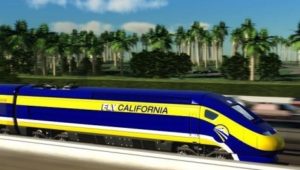 The budget projections for the California high-speed rail seem like a runaway train in and of themselves. Neglecting the initial connection to San Diego, the project is only financed to stretch from San Francisco to Anaheim in its first phase. Originally the project was estimated to cost $45 billion in 2008 but has recently been recalculated to cost between a whopping $98 billion to $118 billion if completed by 2033. And, let’s not be naive, this most likely will not be the final or most expensive estimate given by the High-Speed Rail Authority and the financial burden is sure to affect younger generations of California disproportionately.
The budget projections for the California high-speed rail seem like a runaway train in and of themselves. Neglecting the initial connection to San Diego, the project is only financed to stretch from San Francisco to Anaheim in its first phase. Originally the project was estimated to cost $45 billion in 2008 but has recently been recalculated to cost between a whopping $98 billion to $118 billion if completed by 2033. And, let’s not be naive, this most likely will not be the final or most expensive estimate given by the High-Speed Rail Authority and the financial burden is sure to affect younger generations of California disproportionately.
With the most recent release of the Draft 2012 Business Plan, Assembly members and California representatives feel citizens should have a chance to cast or rescind their support in a new vote for the evolved plan. As of now, the proposed plan does not measure up to the far-reaching scope of what was presented in the original 2008 ballot measure. Initially, 48.5% of voters in San Diego County granted their support in the previous ballot measure. However, I doubt that percentage would hold up today with the notable first phase route exclusion of San Diego and the massive, unrealistic cost of the plan. A public poll now could only be a fair mechanism for facilitating a decision once other concerns are clarified and resolved. The public should have easy access to transparent information about, the schedule of public hearings, the scope of environmental analysis assessments, the price of other expenditures such as investigating suspended or underground options for the train line, and arguably the most important aspect of the rail project: funding. Accurate timelines and estimates of funding from federal grants and appropriations, private and local investments, and state bonds need to be determined. The creation of jobs (a projected 100,000) and the amount of carbon emissions avoided annually (three million tons) are positive aspects for California residents to consider if it does come to a vote.
Most importantly, San Diego businesses and citizens must exhibit a strong presence in the decision-making process for the high-speed rail. This expansive project is an incredibly important, relevant measure where our comments and submissions may actually affect the way in which money is spent. The majority of public opinion seems to support the idea that such a large project with changing, inaccurate cost projections should not be implemented during such an unstable economic time. People’s comments have also raised concerns about the feasibility of the high-speed line delivering passengers from San Diego to San Francisco in 78 minutes at speeds up to 220 miles per hour across the varying topography of California. The new bill is set to be presented to the Legislature in January by Senator Doug LaMalfa, R-Richvale and could then be relayed to public vote. Responsible citizens need to counteract the shrouded planning process and demand accurate information by partaking in the public submissions period and, optimistically, an eventual vote. Citizens should be given the amount of discretion a vote could provide. Whether positively or negatively, a development project of this magnitude will change our natural landscape and state economy for generations to come if implemented.
Important Resources to Consider:
The High-Speed Rail Authority website. Please submit comments on the High-Speed Rail Plan HERE (hyperlink) before December 31:
http://www.cahighspeedrail.ca.gov/home.aspx
McGlone, Ashly, “Bullet train critics call for new vote”, Union Tribune, November 29, 2011. http://www.signonsandiego.com/news/2011/nov/29/critics-call-for-new-rail-vote/?page=3#article







